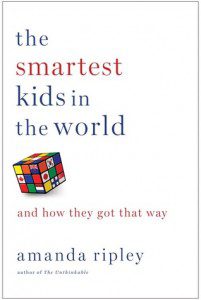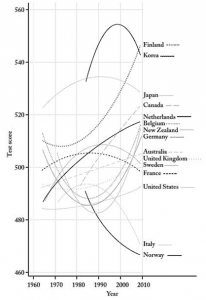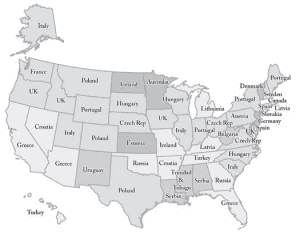This post is part of an ongoing series entitled “Wot-I-Got”. This series acts as a way for me to share Wot-I-Got out of a book or presentation, and to whet your appetite for enquiry. It also forces me to finish books that I start, and to review and summarise my conference notes!
 I recently finished reading Amanda Ripley’s book entitled The Smartest Kids in the World: And How They Got That Way. The book sets out to answer an ambitious question: “Why are some kids learning so much, and some so little?”. Ripley compares internationally lauded educational systems with that of her home country, the U.S, in an attempt to reveal some answers. As a writer for Time Magazine, Ripley doesn’t take the bog standard “what’s similar, what’s different” approach. Instead, she weaves her analysis into a narrative by following the international exchanges of 3 U.S students as they travel to Finland, Korea and Poland. This U.S-student-abroad approach is complemented by also relating the experiences of several foreign students who travelled to the U.S.
I recently finished reading Amanda Ripley’s book entitled The Smartest Kids in the World: And How They Got That Way. The book sets out to answer an ambitious question: “Why are some kids learning so much, and some so little?”. Ripley compares internationally lauded educational systems with that of her home country, the U.S, in an attempt to reveal some answers. As a writer for Time Magazine, Ripley doesn’t take the bog standard “what’s similar, what’s different” approach. Instead, she weaves her analysis into a narrative by following the international exchanges of 3 U.S students as they travel to Finland, Korea and Poland. This U.S-student-abroad approach is complemented by also relating the experiences of several foreign students who travelled to the U.S.
The book is set out in chapters based on the seasons of Fall, Winter and Spring throughout which the exchanges occurred. It also has two appendices. A1: How to Spot a World-Class Education, and A2: AFS Student Experience Survey.
Amanda brings together her findings in a one word answer to the question posed above, “Rigor”. She concludes that setting high expectations for students, and encouraging/supporting students to meet those expectations is what sets an excellent education apart from an average one.
I thoroughly enjoyed the book. The practical advice about spotting a good school in appendix 1 is a particularly useful section and I enjoyed the narrative style of communication. It did give an excellent insight into the cultural differences between education in the 4 different countries and I feel that I came away with a much better understanding of the strengths and weaknesses of each. My main criticism for the book is the lack of any formal referencing style. References are included in the back however many statistics are noted in the book with no direct link made between the in-text comment and the source.
I hope you enjoy the following selected collection of my take-away notes from the book (included below). The left hand number refers to the page number and the right hand number refers to the kindle location.
3, 93: Graph: ‘Dance of the Nations’-showing changes in test performance through (right)
time for 18 different countries from ca. 1960-2010. (constructed from a compilation of eighteen different tests by economists Ludger Woessmann and Eric Hanushek)
13, 193: Person: Thomas Neville Postlethwaite-‘educational scientist’ (using data to measure education) who’s work inspired Andreas Schleichter’s approach to PISA
note: Andreas Schleichter is the co-creator (with Thomas Neville Postlewite) of the first international reading test which became the foundation for PISA
17, 255: Private school for American children does not, statistically speaking, add much value after correcting for home environment (this is one of those examples where I’d love to see the reference!)
18, 266: Change in educational outcomes for a country can come within a single generation, based on historical tests in finland (again, reference would be great)
19, 276: Quote: ‘Without data, you are just another person with an opinion”-Andreas Schleichter
63, 913: Quote: “The quality of an education system cannot exceed the quality of its teachers”-anonymous Korean policymaker
90, 1288: In 2009 Rhode Island under the guidance of educational commissioner Deborah Grist raised minimum test scores for enterance into teaching, read for the results.
92, 1288: Under the new teacher entry standards, approx 85% of Rhode Island College’s current (at the time) education student’s wouldn’t have made it in
94: 1335: “A large majority of elementary education majors are afraid of math”-An Okloahoma math department chair, 2005 survey.
113, 1617: Book: Teach Like a Champion, Doug Lemov
137, 1985: Peer effects are very influential. Once polish student were streamed into vocational schools their academic gains (through streaming later) were lost and their abilities often when backwards
138, 1990: “in general, the younger the tracking (streaming) happened, the worse the entire country did on PISA (again, reference?)
139, 2018: Finnish teachers can’t, as a rule, hold students back a year. Instead, Finland helps students very early whenever they show signs of slipping. ⅓ of students get special help in their first 9 years of school and only 2% repeat a grade in primary school (vs. 11% in the US)
142, 2060: Quote: “Kids meet the expectations you set for them”-Mark Blanchard, Gettysburg High School principal
173, 2480: In a survey, Korean students rated their Hagwon teachers higher than their school teachers. Ripley briefly discusses whether this suggests that competition in a private market yields better educational results.
180, 2573: Image-The U.S. revisited: If states were countries, which countries would they be? (Based on PISA ranking) (right)
182, 2604: Here in the book is an excellent segment on the importance of mathematics for even low-skilled line (manufacturing) jobs. Comments coming from Paula Marshall of Bama Companies, a pie manufacturer
Wot-I-Got. Appendix 1: How to Spot a World-Class Education
208, 2953: Watch the students. “Watch for signs that all the kids are paying attention, interested in what they’re doing, and working hard. Don’t check for signs of order…Some of the worst classrooms are quiet, tidy paces.”
210, 2980: Ask the students: “What are you doing now?”, “Why?”. “To buy into a school, kids need to be reminded of the purpose all day, everyday
210, 2982: Study: 2011 Gates foundation research study*; found that kids’ answers to some specific questions were very predictive of their test-score growth and more reliable than classroom observations by trained observers. *The Tripod Study, designed by Ronald Ferguson at Harvard
214: “In most of the highest performing systems, technology is remarkably absent from classrooms”-Andreas Schleicher. “it does seem that those systems place their efforts primarily on pedagogical practice rather than digital gadgets.”.
215, 3052: Ask the principal at a school “How do you choose your teachers?” then ask the follow up question (see pp 216)
215, 3059: Also ask principals: “Do you watch your job applicants teach?
216, 3070: Ask principal: “How do you help teachers collaborate”, “what kind of leadership roles do you give your top teachers?”
218, 3094: on Parental involvement at Success Academies: Comprised of reading to kids 6 nights per week etc. Parent’s have mobile phone numbers of their kid’s teachers and principal
221, 3139: Maths skills are a better predictor of future earnings/economic outcomes than other subjects. (reference?)
Wot-I-Got. Appendix 2: AFS Student Experience Survey
224, 3388: See for results on distribution and use of technology in classrooms in different countries (I won’t give away all of Ripley’s results!)
225, 3404: “92% of international and 70% of U.S students said school in U.S is easier than school abroad”
226, 3416: “This finding is consistent with the thesis of this book: In countries with strong education systems, school is actually harder. Rigor runs through those countries’ approaches to learning and parenting, shaping everything from teacher training to the make-up of standardized tests
227, 3428: “International students from high-performing countries were much more likely than students from lower-performing countries to report that the U.S. parents gave their children much less freedom.”
229, 3455: It is the relative importance of sports to academia in U.S. Schools that is a worry.
231, 3479: “To work, praise must be specific, sincere, accurate-and used in moderation”

